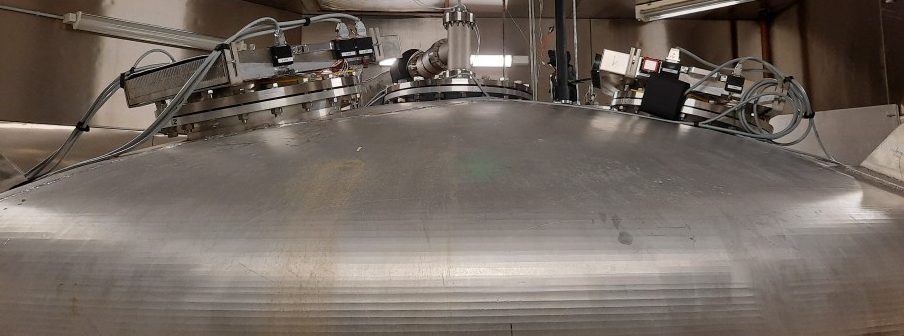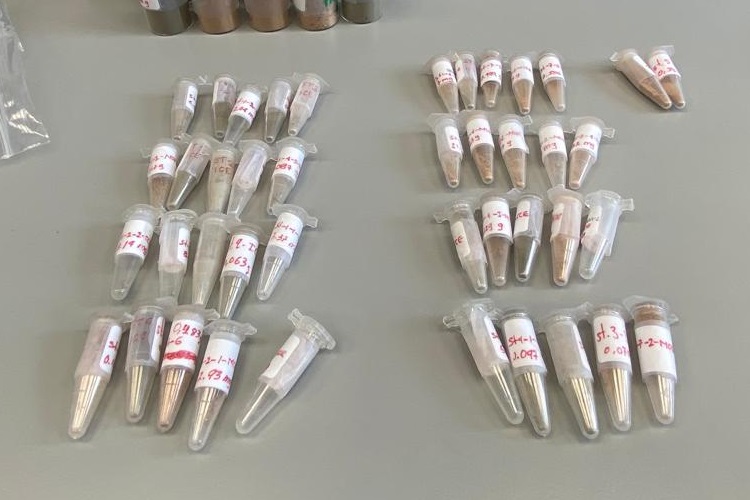The hard core of clouds
Cloud-ice crystals form much easier around particles in the atmosphere, so-called ice nucleating particles (INP), than without. Mineral dust particles are known to be very efficient INP, but this efficiency varies with the mineralogical composition, size, and other properties [1]. To quantify the impact of mineral dust on cloud formation with atmospheric models, the accurate representation of such dust properties is important.
Until recently, differences in the mineralogical composition of mineral dust, which may arise depending on the location at which the dust was emitted, were not considered. This has now been changed [2, 3] and this new capability of models to simulate the emission and transport of dust minerals paves the way for a more nuanced representation of dust-cloud interactions in models depending on dust composition and mixing state.

Besides composition, particle size is a pivotal property to assess the efficacy at which dust particles act as INP. Recent studies have shown that airborne dust particles much larger than previously thought (up to around 400 µm, the size of coarse beach sand) can be carried in the air over thousands of kilometers [4]. As particle size, insolubility, and a crystallographic structure – all properties associated with coarse mineral dust - favor INP efficiency, large mineral dust particles are expected to be particularly suitable as INP. However, laboratory experiments on cloud-ice nucleation have usually been limited to much smaller particle sizes, not least due to technical challenges associated with the large and heavy particles.
Cloud-ice crystals form much easier around particles in the atmosphere, so-called ice nucleating particles (INP), than without. Mineral dust particles are known to be very efficient INP, but this efficiency varies with the mineralogical composition, size, and other properties [1]. To quantify the impact of mineral dust on cloud formation with atmospheric models, the accurate representation of such dust properties is important.
Until recently, differences in the mineralogical composition of mineral dust, which may arise depending on the location at which the dust was emitted, were not considered. This has now been changed [2, 3] and this new capability of models to simulate the emission and transport of dust minerals paves the way for a more nuanced representation of dust-cloud interactions in models depending on dust composition and mixing state.

Samples were collected in field campaigns in Morocco and Iceland
and separated into different size ranges.
A team of researchers from KIT’s IMK-TRO and IMK-AAF, the Barcelona Supercomputing Center, the Technical University Darmstadt, the Institute of Environmental Assessment and Water Research, and the University of Crete, have now taken on this challenge and conducted a laboratory campaign in the renowned AIDA cloud chamber. The campaign was called MICOS (“Dust-induced ice nucleation: Effects of MIneralogical COmposition and Size”) and had the goal to systematically investigate dust-induced ice nucleation by size – extending the typical particle-size range for which cloud chamber experiments are conducted toward larger sizes – for natural mineral dust samples of considerably different mineralogical composition. For this purpose, a special experiment design was created, including, e.g. a new method to inject the dust particles into the AIDA chamber, combining AIDA with its smaller counterpart AIDAmini [5], and repeating the particle injection. Analysis of the experiments is currently ongoing and will be reported in due course. Stay tuned!
MICOS was granted under ATMO-ACCESS and is part of a project that is supported by the European Commission under the Horizon 2020 – Research and Innovation Framework Programme, H2020-INFRAIA-2020-1, Grant Agreement number: 101008004.
[1] Kiselev, A., Bachmann, F., Pedevilla, P., Cox, S. J., Michaelides, A., Gerthsen, D., and Leisner, T.:Active sites in heterogeneous ice nucleation—the example of K-rich feldspars, Science, 355 (6323), 367-371 doi:10.1126/science.aai8034, 2016.
[2] Gonçalves Ageitos, M., Obiso, V., Miller, R. L., Jorba, O., Klose, M., Dawson, M., Balkanski, Y., Perlwitz, J., Basart, S., Di Tomaso, E., Escribano, J., Macchia, F., Montané, G., Mahowald, N., Green, R. O., Thompson, D. R., and Pérez García-Pando, C.: Modeling dust mineralogical composition: sensitivity to soil mineralogy atlases and their expected climate impacts, EGUsphere [preprint], https://doi.org/10.5194/egusphere-2022-1414, 2023.
[3] Li, L., Mahowald, N. M., Miller, R. L., Pérez García-Pando, C., Klose, M., Hamilton, D. S., Gonçalves Ageitos, M., Ginoux, P., Balkanski, Y., Green, R. O., Kalashnikova, O., Kok, J. F., Obiso, V., Paynter, D., and Thompson, D. R.: Quantifying the range of the dust direct radiative effect due to source mineralogy uncertainty, Atmos. Chem. Phys., 21, 3973–4005, https://doi.org/10.5194/acp-21-3973-2021, 2021.
[4] van der Does, M., Knippertz, P., Zschenderlein, P., Harrison, R. G., and Stuut, J.-B. W.: The mysterious long-range transport of giant mineral dust particles, Sci. Adv., 4, eaau2768, doi:10.1126/sciadv.aau2768, 2018.
[5] Vogel., F., L. Lacher, J. Nadolny, H. Saathoff, T. Leisner, and O. Möhler: Development and validation of a new cloud simulation experiment for lab-based aerosol-cloud studies, Rev. Sci. Instrum., 93, 095106, doi:10.1063/5.0098777, 2022.
M. Klose, J. Holzwarth, and Sebastian Vergara Palacio, WG Mineral Dust, https://www.imk-tro.kit.edu/english/10519.php
